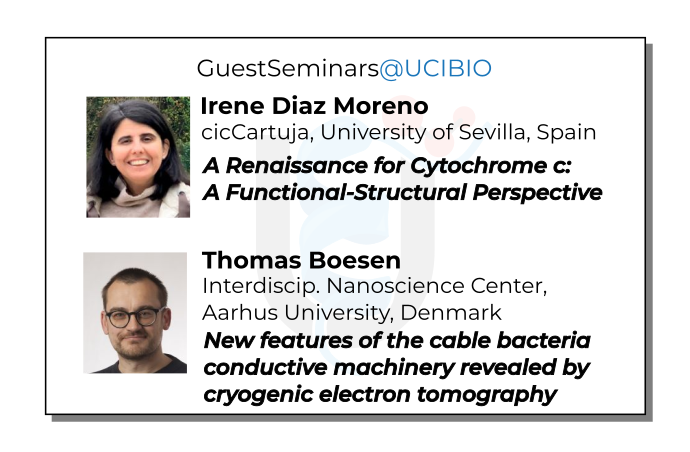
A Renaissance for Cytochrome c: A Functional-Structural Perspective
Irene Diaz Moreno, Centre of Scientific Research Isla de la Cartuja (cicCartuja), University of Sevilla, Spain
New features of the cable bacteria conductive machinery revealed by cryogenic electron tomography
Thomas Boesen, Interdisciplinary Nanoscience Center and Department of Molecular Biology and Genetics, Aarhus University, Denmark
Host: Leonor Morgado, UCIBIO-NOVA
ZOOM link: https://ucibio.pt/l/GuestSeminars
Abstracts:
Irene Diaz Moreno:
The crosstalk between the mitochondrion and the nucleus regulates cellular functions, including differentiation and adaptation to stress. Mitochondria supply metabolites and certain mitochondrial factors, which have emerged as response elements to cell nucleus performance. Thus, unraveling the whole connectivity between the biomolecules involved in all this regulatory mitochondria-nucleus crosstalk and its relation to cell fate and physiological state is nowadays a major challenge.
In the lecture, I will show novel mechanistic insights into electron transfer (ET) from cytochrome c1 to cytochrome c1, including gated, long-range ET in aqueous solution. Remarkably, a close contact between cytochrome c1 and cytochrome c is not essential for ET: when proteins are approaching each other, cation exclusion occurs between their active sites, enabling the building of a Gouy-Chapman charge conduit and the long-distance ET through the aqueous solution.2 Acetylation and phosphorylation of cytochrome c not only affects its structure and dynamics,3,4,5 but also shortens the long-distance charge conduit between the partners, strengthens their interaction, and departs it from equilibrium.6,7
In response to DNA damage, cytochrome c escapes from its natural mitochondrial environment and, once in the cytoplasm, binds to Apaf-1 to form a complex—the so-called apoptosome—that triggers caspase activation and further leads to controlled cell dismantlement. Recent work from our group shows that cytochrome c in the cytoplasm also binds to the chaperone 14-3-3ε, which is an inhibitor of Apaf-1, to block 14-3-3ε-mediated Apaf-1 inhibition, thereby unveiling a novel function for cytochrome c as an indirect activator of caspase-9/3.8,9
Besides such key apoptotic roles of cytochrome c in the cytoplasm, its migration to the nucleus soon after DNA damage—even before caspase cascade activation and apoptosome formation in the cytoplasm—has recently been an exciting discovery.10 Cytochrome c in the nucleus actually targets a variety of well-known histone chaperones involved in chromatin remodeling and DNA damage response.11-16 Our results show that nuclear/nucleolar cytochrome c inhibits the nucleosome (dis)assembly activity of histone chaperones, impairs dephosphorylation events and controls p53-mediated cell cycle arrest during the repair of injured DNA.12-14 Histone chaperones do interact with cytochrome c lysine residues through their acidic disordered regions, which are involved in the heterotypic contacts leading to liquid-liquid phase transitions and are responsible for the assembly of nuclear condensates, including heterochromatin.14,17 Altogether, our recent data demonstrate that cytochrome c functions as a master, pleiotropic organellar factor, thereby playing a crucial global role in cell metabolism, both in life and death.
References
1 Pérez-Mejías et al. (2022) Coord Chem Rev 450: 214233
2 Lagunas et al. (2018) Nat Comm 9: 5157
3 Moreno-Beltrán et al. (2017) PNAS 114: E3041
4 Guerra-Castellano et al. (2018) PNAS 116: 7955
5 Morse et al. (2023) Nat Comm 14: 4166
6 Gomila et al. (2022) Nat Comm 13: 7100
7 Lagunas et al. (2024) Nat Chem under review
8 Elena-Real et al. (2018) Cell Death Dis 9: 365
9 Elena-Real et al. (2021) Plant J 106: 74
10 González-Arzola et al. (2015) PNAS 112: 9908
11 González-Arzola et al. (2017) Nucleic Acids Res 45: 2150
12 Rivero-Rodríguez et al. (2021) Redox Biol 43: 101967
13 Casado-Combreras et al. (2022) Comp Struct Biotechnol J 20: 3695
14 González-Arzola et al. (2022) Nat Struct Mol Biol 29: 102414
15 Buzón et al. (2023) Adv Sci 7: e2301859
16 Baños-Jaime et al. (2024) Adv Sci under review
17 Casado-Combreras et al. (2024) iScience 20: 3695
Thomas Boesen:
Very little is currently known about the molecular composition and structural properties of the periplasmic conductive fibers (PCFs) and the overall ultrastructural organization of the conductive machinery in cable bacteria. We employed a range of electron microscopy methods to study the ultrastructural details and elemental composition of the cable bacteria PCFs. Cryogenic electron microscopy was used to obtain 3D tomograms of focused ion beam milled cable bacteria cells. Analysis of the data revealed novel and intriguing cellular structures in close connection to the PCFs. Scanning transmission electron microscopy (STEM) combined with energy-dispersive X-ray spectroscopy (EDX) was used to obtain information about the elemental composition of cable bacteria filaments with a focus on understanding the elemental composition of the PCFs. Interestingly, the results showed high relative amounts of iron, nickel, and sulfur co-localizing with the PCFs. Based on the results obtained a new ultrastructural model of the conductive machinery in cable bacteria will be presented.
Short Bio:
Irene Diaz Moreno - Irene Díaz-Moreno is Full Professor of Biochemistry and Molecular Biology and the leader of the Biointeractomics Research Group at the Institute for Chemical Research (IIQ), of the Scientific Research Centre Isla de la Cartuja. cicCartuja is a multidisciplinary research center between the University of Seville, the Spanish National Research Council (CSIC), and the Andalusian Government (Junta de Andalucía). The Biointeractomics Research Group boasts extensive experience in the molecular recognition of metalloproteins, structure-function relationships of signaling proteins, and transient protein-protein and protein-nucleic acid interactions. The Group studies the importance of these interactions in various cellular processes, including the DNA damage response.
Irene Díaz-Moreno joined cicCartuja after a postdoctoral stay at the National Institute for Medical Research, Medical Research Council in London (UK), working on the regulatory mechanisms of mRNA decay by RNA-binding proteins and funded by an EMBO fellowship. In 2010, she got a permanent position at the University of Seville, where her research and her passion focuses on the role of intrinsically disordered domains in multivariant molecular contacts that govern liquid-liquid phase transitions leading to biomolecular condensates assembly.
She is the editor of two books, Editor-in-Chief of International Union for Biochemistry and Molecular Biology (IUBMB) BioFactors journal and has published more than 100 articles in scientific journals (Nat Struct Mol Biol, Nat Comm, PNAS, NAR, etc). She is also giving numerous talks at national and international congresses.
She has been involved in several committees and journals of IUBMB and Federation of European Biochemistry Societies (FEBS) over the past decade, including as Chair of the IUBMB Nominating Committee and member of the FEBS Executive Committee as Chair of the Careers of Young Scientists Committee. She is the current Vice President of the Spanish Society of Biochemistry and Molecular Biology and Vice Chair of the European Commission MSCA Postdoctoral Fellowships in the Life Panel.
Thomas Boesen - I obtained my PhD in medical microbiology at Aarhus University in 2002 and subsequently took position as Assistant Professor and later Associate Professor at Department of Molecular Biology and Genetics, Aarhus University. In 2016 I was appointed Head of the Cryo-EM Facility and in 2021 Senior Researcher at the Interdisciplinary Nanoscience Center (iNANO), Aarhus University, and was deeply involved in establishing the Danish National cryo-EM Facility (EMBION) in collaboration with key stakeholders from the University. This facility now harbors two high-end Titan Krios microscopes and several accessory microscopes and advanced EM equipment (embion.au.dk).
I have a background in molecular and structural biology and primarily use X-ray crystallography and cryo-EM single particle analysis for atomic structure determination of proteins. In addition, I employ a range of EM methods for high resolution ultrastructural analysis of bacteria and have implemented new workflows for cryogenic electron tomography studies on bacteria using cryoFIB/SEM and cryoCLEM equipment for lamella production and target localization, respectively.
My focus in CEM is the biochemical, functional, and structural analysis of the conductor machinery and cytochromes involved in electron transfer networks in cable bacteria.
